Jell-O and the Kewpies. New York: American Lithographic Co., 1915.
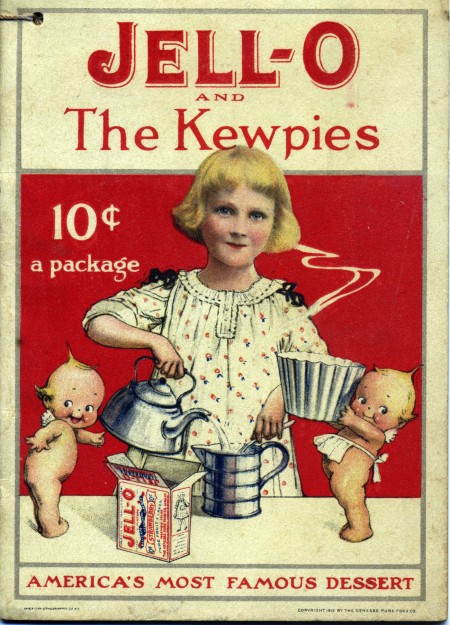
When I was twelve years old, we moved from a semi-suburban, overwhelmingly Mormon neighborhood to a neighborhood full of hippies. My Jell-O consumption, already shaken by the disappearance of my beloved Jell-O 1-2-3, took a nosedive. Gone were the block parties and playdates with their lime Jell-O jigglers and pistachio puddings; my mother started buying fruit leather and hummus from the local food co-op instead. Over the last few years, in my own mildly reactionary way, I have found my way back to Jell-O. I now own at least three Jell-O cookbooks and a variety of molds. I even had myself convinced at one point that Bavarian Creams (Jell-O style, of course) were just the thing for summer entertaining.
Continue reading Jell-O and the Kewpies
Helps for the Hostess. Camden, NJ: Joseph Campbell Company, 1916.
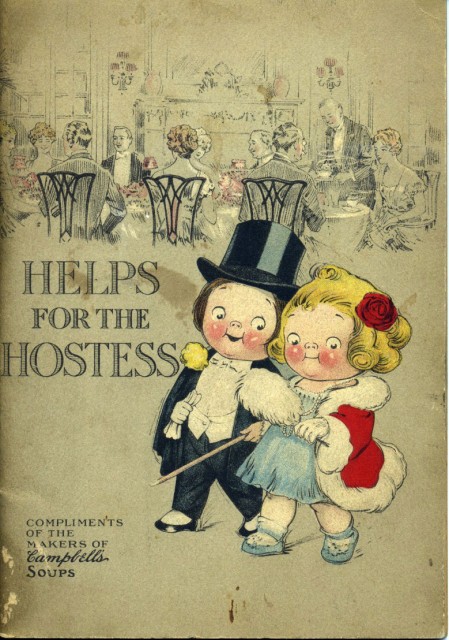
I was going to begin this post by triumphantly declaring that I didn’t own a single can of Campbell’s soup. But when I went to the kitchen to double-check, I found (of course) a can of cream of mushroom. I have no idea where it came from, but there it was. My mother, raised in California in the 1950s and thus perversely fond of canned soups, would be proud. Some quick back-of-the-envelope math leads me to believe that I ate chicken breasts with cream of mushroom soup approximately three hundred times between the years of 1978 and 1996; green bean casserole (canned green beans, water chestnuts, cream of mushroom soup, Durkee French-fried onions) probably accounts for another hundred and fifty or two hundred exposures. My Campbell’s soup consumption, aside from the occasional can of chicken noodle when I was under the weather, was mostly in the form of these casseroles. I was not alone. John Thorne, in his wonderful Mouth Wide Open, points out that “purchasers us[e] one of every three cans as a recipe ingredient; with cream of mushroom soup, that figure jumps to 80 percent.”
Until 1916, when Campbell’s published Helps for the Hostess, canned soups were primarily marketed as, well, soups. Perhaps realizing that the demand for clam bouillon and mutton soup had its limits, Campbell’s devised new recipes. For the first time, the soups were used as recipe ingredients, rather than as stand-alone courses. Helps for the Hostess starts off with menus featuring Campbell’s soup, but eventually moves on to aspic, pointing out that with Campbell’s consommé and bouillon “you [could] have a crystal-clear aspic without any labor.” No more “trouble boiling, straining with egg whites, etc.:” Â
Continue reading Helps for the Hostess
Margolis, Jack S. and Daud Alani. Cooking for Orgies and Other Large Parties. Los Angeles: Cliff House Books, 1972.
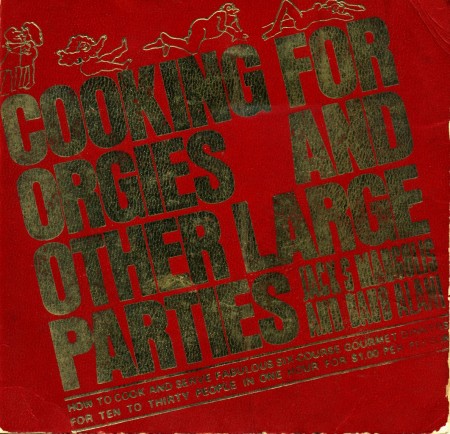
I have been known to buy them in moments of weakness, but I don’t really approve of joke cookbooks. I own dozens of cookbooks with barely usable recipes, but I make a distinction between books that are intentionally bad and those that have merely aged poorly. Cooking for Orgies and Other Large Parties: How to Cook and Serve Fabulous Six-Course Gourmet Dinners for Ten to Thirty People in One Hour for $1.00 per Person has always been a crowd pleaser, though, and I feel some genuine affection for it.
The authors, Jack S. Margolis and Daud Alani, claim to be “Hollywood Bachelors” with no first-hand knowledge of orgies. Their “friend,” Ernie Lundquist, “has an orgy…every Wednesday night at 9:00 p.m.,” and has taught them everything they know. Perhaps because of their lack of experience, or perhaps, as I suspect, because they are mostly excited about their cooking method (see below), Margolis and Daud don’t devote much of the book to talk of orgies. There are naughty line drawings throughout, and there is a perfunctory “Special Consideration” section at the beginning, complete with a suggested time-table (“9:30-12:00: Free Play”), but that’s about it:
Continue reading Orgies and Other Large Parties
Better Homes and Gardens Guide to Entertaining. New York: Meredith Books, 1969.
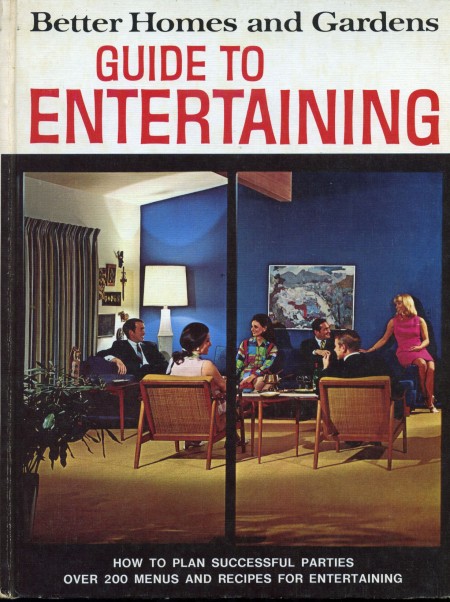
My favorite book about entertaining is, without a doubt, Elsa Maxwell’s How to Do It, but the Better Homes and Gardens Guide to Entertaining has its moments too. Published in 1969, it covers everything from picking the right guests (“a party revolving around touch football would be inappropriate for your elderly friends”) to the setting (“You can even decorate the garage, carport, or attic, for parties if you wish”) and, of course, the menu (“if you’ve invited foreign guests–their religion will often determine what they can eat”). Relentlessly upbeat, it promises a “comprehensive treatment of all elements of entertaining so that you may find the answer to any hostessing problem.” The solutions they suggest to these problems resemble, at best, the set of a Douglas Sirk movie and, at worst, a Jell-O and maraschino cherry fueled nightmare. I think this table setting falls squarely in the center of that continuum: Â
Continue reading “Pickle-Sickles” and Other “Colorful” Treats
Fobel, Jim. Beautiful Food. New York: Van Nostrand Reinhold, 1983.
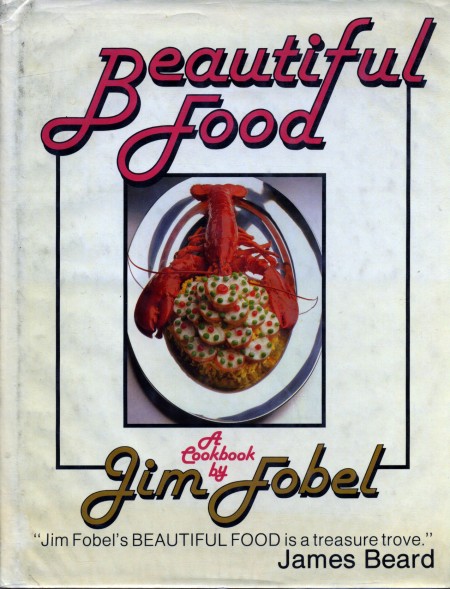
The lacquered lobster on the cover was all it took. I was unable to resist buying Jim Fobel’s Beautiful Food  when I found it in a used bookstore several years ago. To its credit (as promised on the jacket), it has been a “constant source of delight and inspiration to [me]” since then. Possibly more delight than inspiration–I’ve never actually made any of the recipes, which range from the merely fussy to the totally insane. The premise of the cookbook is that “meals in minutes” must be vanquished, and that food should be as much (or more) about appearance as taste. While I’m all for lovely presentation, Fobel sometimes took things a bit too far, in a completely charming sort of way. On Thanksgiving, for instance, he recommended dressing up the turkey “with a tailor-made pastry outfit,” otherwise known as a tuxedo:
Continue reading A Turkey in a Tuxedo
Oliver, Michel. La Cuisine Est Un Jeu D’Enfants. Paris: Plon, 1963.
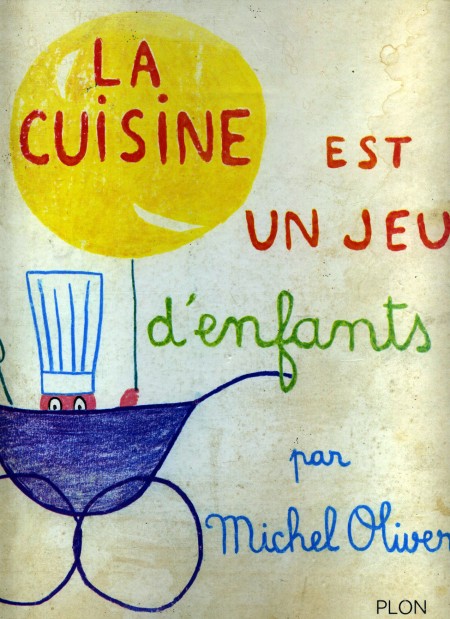
Brief infatuation with From Mr. Bingle’s Kitchen aside (the recipe for fruit pizza was and is awesome), I never had much interest in children’s cookbooks. I was a strictly Better Homes and Gardens kind of girl. (I have a weakness for binders, not to mention plaid.) From what I could tell I wasn’t missing much, just a lot of knife-less, stove-less, fun-less recipes. My position has softened a bit lately. I’ve found a few good books (see Alice Waters, Marion Cunningham, Heston Blumenthal), and at least one great one: Michel Oliver’s La Cuisine Est Un Jeu d’Enfants*. It has whimsical illustrations, ambitious recipes (coq au vin, cheese soufflé), and an introduction by Jean Cocteau. I would have *loved* this book when I was eight. Take, for instance, this recipe for Lapin à la Moutarde:
Continue reading Child’s Play
So, obviously, I haven’t updated this blog in a while. I promise to do something substantive about that soon. Very soon. In the meantime, I have a small offering. I helped out with this a year or so ago. It’s me, talking about some of my favorite cookbooks.
War Shipping Administration, Food Control Division. Cooking and Baking on Shipboard. Washington: GPO, 1945. 358pp.
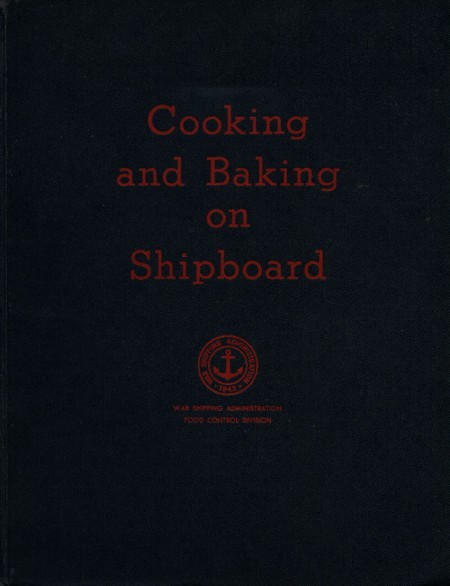
The Food Control Division of the War Shipping Administration (the agency that oversaw Merchant Marine ships during WWII) published several books about managing food and cooking while at sea. Though I don’t use it much for recipes (they all serve 100), I have a copy of one of them, Cooking and Baking on Shipboard. Published in 1945, it is full of bland food and remarkable illustrations of butchery. Pages and pages of how to cut up a cow. Followed by pages and pages of how to cut up a pig. And then a couple of recipes for biscuits and mashed potatoes thrown in for good measure. In the earnest letter that accompanies the book, Harold J. O’Connell (Director, Food Control) explains that it provides “the most up-to-date and efficient suggestions for planning and making better meals,” exactly what the stewards, cooks, and bakers need to run “the best-feeding Merchant Marine in the world:”
Continue reading The Best-Feeding Merchant Marine in the World
Erlanger, Baba and Daren Pierce. The Compleat Martini Cook Book. Illus. Elizabeth Fraser. New York: Random Thoughts, 1957.
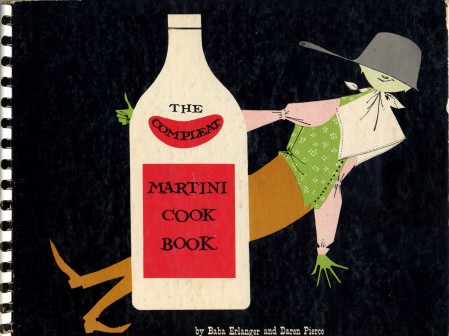
My mother barely drinks at all, and while my father does, it’s in a decidedly unglamorous cans-of-bud-lite and jugs-or-sometimes-even-boxes-of-red-wine kind of way. Either because, or perhaps in spite of my upbringing, I’ve always liked the idea of serious, yet controlled, drinking, the kind done by ad men and literary types in movies from the 1950s and 60s. Hence my fondness for the The Compleat Martini Cook Book. Clearly a farce (the authors report being “shoved” from their “Newport nest” at the tender age of 34), the book nonetheless includes some fairly edible-seeming recipes, arranged in order of how many martinis should be drunk before attempting to cook them. The instructions take into account the sobriety of the chef, suggesting, sensibly, that knives should probably be avoided after four or five drinks. I chose the recipe below because it includes pickled beets (yum!) and because I LOVE the illustration. I think it perfectly captures that green, yet languid, state that can be reached after a night of hard drinking:
Continue reading Passing the Soup Before Passing Out
Marinetti, Fillippo Tommaso. The Futurist Cookbook. Trans. Suzanne Brill. San Francisco: Bedford Arts, 1989.

Written by F. T. Marinetti, The Futurist Cookbook was published in 1932 in Italy. The book aimed to bring the tenets of Futurism into the kitchen, via “aerofood” served at meals with grandiose names like the “Synthesis of Italy Dinner” and the “Get-Up-to-Datee.” Marinetti had a special vitriol for pasta; he felt it made the Italians sluggish and complacent. He proposed a radical new cuisine, based on the idea of food as art rather than food as sustinence. Lesley Chamberlain, in her introduction to the cookbook, argues that Marinetti’s proposal was, in fact, “one of the best artistic jokes of the century.” The thrust of the book does seem to be more about performance than consumption, but serious or not, it’s certainly good fun.
The names of the dishes are all fantastic. Some of my favorites: Tasty Equator + North Pole; Like a Cloud; Futurist Risotto with Cape Gooseberries; Carnaleap; More-Less-By-Division; Fisticuff Stuff; Manandwomanatmidnight; Strawberry Breasts; Senate of the Digestion; Pocket Book Turnips; and, of course, Carrot + Trousers = Professor. A few of the recipes are also accompanied by helpful little illustrations, like the Tennis Chop below:
Continue reading Elasticakes and Tennis Chops
|
|








